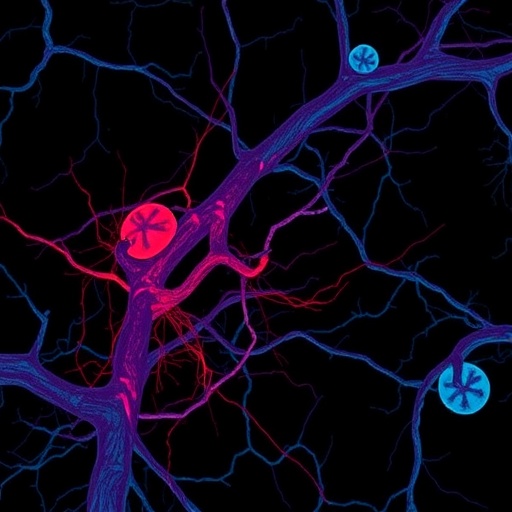In a significant advancement in the field of ophthalmology and systemic lupus erythematosus (SLE) research, a recent study has revealed critical findings regarding the impact of this autoimmune disease on ocular health. Conducted by a team of researchers led by Chen, L., Sun, L., and Meng, L., this investigation employed advanced imaging techniques to elucidate the loss of microvascular structures in both the conjunctiva and the retina of patients diagnosed with SLE. The implications of these findings could reshape our understanding of the systemic effects of lupus and its associated comorbidities.
One of the standout methodologies employed in this study is swept-source optical coherence tomography angiography (OCTA). This cutting-edge imaging technique offers improved visualization of microvascular networks compared to traditional imaging modalities. By utilizing swept-source OCTA, the researchers were able to capture high-resolution images that provided insight into the vascular changes occurring in the eyes of individuals suffering from SLE. The use of such technology marks a turning point in assessing microvascular health in autoimmune diseases.
The study involved a cohort of SLE patients, which allowed the researchers to compare their findings against control subjects without the disease. The results revealed a statistically significant reduction in the density of both conjunctival and retinal microvasculature among the SLE patients. This vascular loss raises concerns about the potential long-term visual implications for lupus patients, highlighting an urgent need for further research in this area.
Interestingly, the correlation between microvascular loss and disease activity was a critical component of the study. The researchers discovered that patients exhibiting more severe systemic lupus symptoms also showed greater reductions in vascular density. This observation suggests that ophthalmic assessments could potentially serve as an adjunct tool for monitoring disease progression and activity in SLE patients.
Beyond the immediate implications for ocular health, these findings open up broader discussions regarding the systemic nature of systemic lupus erythematosus. SLE is recognized for its heterogeneous presentation and the potential for multi-organ involvement, including the cardiovascular and renal systems. Understanding how this disease impacts the microcirculation in the eyes adds valuable knowledge to the existing literature and may have implications for targeted therapeutic strategies.
As autoimmune diseases like SLE become more prevalent in the global population, the need for innovative approaches to monitoring and managing these conditions is paramount. The study’s results advocate for a shift in focus towards the eyes, which could serve as a non-invasive window into the overall health of individuals with SLE. Furthermore, addressing microvascular health could lead to improved quality of life for these patients, emphasizing the importance of comprehensive care models.
While the present study primarily demonstrates the potential of using OCTA as an evaluative tool for ocular manifestations in lupus patients, it also invites speculation about the underlying mechanisms responsible for the observed microvascular loss. Inflammation and immune dysregulation are hallmarks of SLE, and it remains to be seen how these factors directly contribute to vascular changes in the eye. Future studies would benefit from exploring these relationships in greater depth.
The implications of this research extend not only to clinical practice but also to the research community. As scientists delve deeper into the intricacies of SLE, collaborations between ophthalmologists, rheumatologists, and immunologists will be vital to develop a holistic understanding of the disease. Such interdisciplinary approaches could yield new insights into potential biomarkers for SLE, enhancing diagnostic accuracy and therapeutic strategies.
Moreover, the findings could lead to advancements in treatment protocols. If microvascular loss is identified early in the disease trajectory, interventions aimed at preserving vascular health could become a focal point of management for SLE patients. The potential for preventative strategies adds another layer of significance to the study and suggests that ongoing research is essential.
In conclusion, the work by Chen et al. exemplifies the vital intersection of technology and clinical research in uncovering the complexities of systemic lupus erythematosus. By shedding light on the microvascular implications of this autoimmune disease, the study not only contributes to the academic understanding but also serves as a clarion call for enhanced patient care strategies. As we look to the future, it is clear that further investigation is warranted to fully understand the ocular manifestations of SLE and their broader ramifications on patient health and wellbeing.
Through continued exploration and validation of these findings, the medical community may unlock new avenues for improving outcomes for individuals living with systemic lupus erythematosus. Such advancements will undoubtedly rely on the collective efforts of researchers and clinicians dedicated to understanding and treating this multifaceted disease more effectively.
As the landscape of autoimmune research evolves, the role of innovative imaging techniques will likely become increasingly critical in advancing our grasp of systemic diseases. Ultimately, the study serves as a powerful reminder of the interconnectedness of bodily systems and the importance of a comprehensive approach to health, particularly for those affected by complex autoimmune disorders like SLE.
Subject of Research: Microvascular loss in systemic lupus erythematosus.
Article Title: Conjunctival and retinal microvascular loss in systemic lupus erythematosus: a swept-source OCTA study.
Article References:
Chen, L., Sun, L., Meng, L. et al. Conjunctival and retinal microvascular loss in systemic lupus erythematosus: a swept-source OCTA study.
J Transl Med 23, 1073 (2025). https://doi.org/10.1186/s12967-025-07118-6
Image Credits: AI Generated
DOI: 10.1186/s12967-025-07118-6
Keywords: Systemic lupus erythematosus, OCTA, microvascular loss, autoimmune disease, ocular health.




